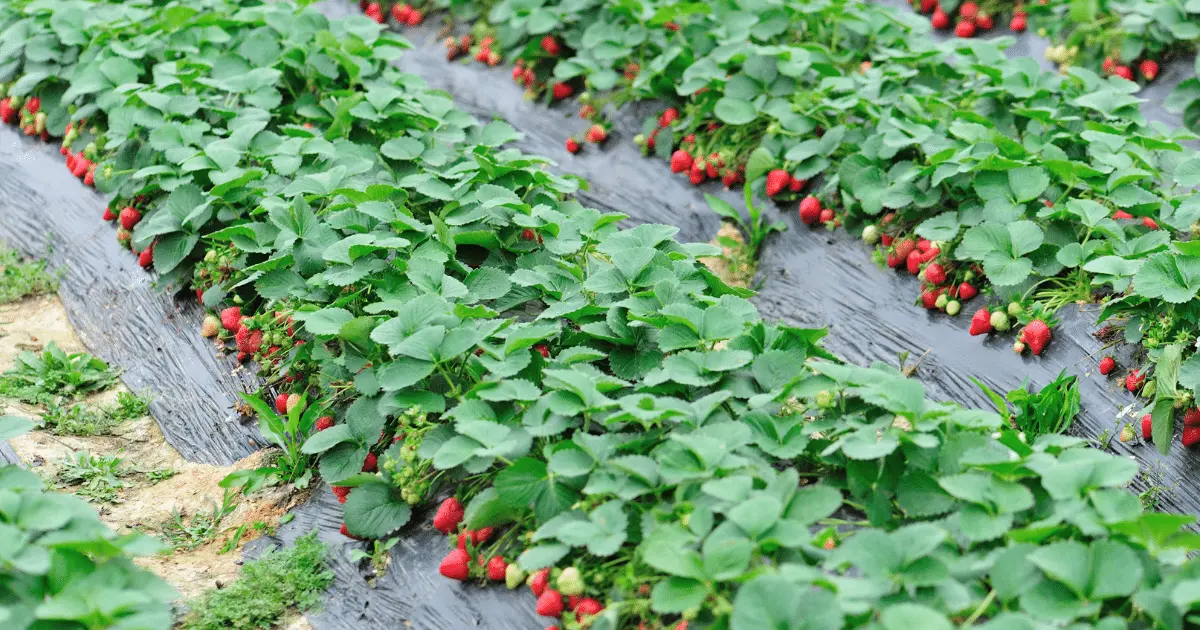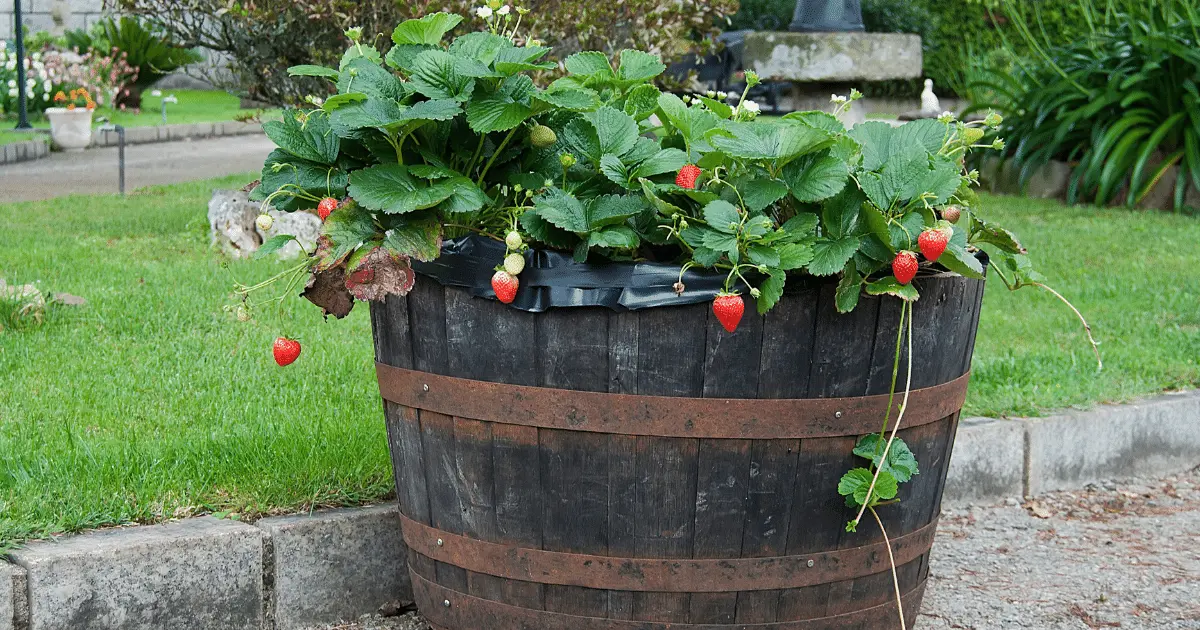Are you wondering how to go about planting your strawberries? Worry no more. I have curated the ultimate guide to help you space your strawberries. The spacing will determine how well your harvest will turn out, whether you are spacing day-neutral, ever-bearing, or June-bearing strawberries.
Depending on the strawberry variety, the design of your garden, and your financial situation, strawberry plants can be spaced as close as 8 inches apart or, in some situations, as far apart as several feet. But that isn’t all there is to spacing strawberries; I will go into more detail as you read.
How Far Apart to Space Strawberry Plants

As I mentioned earlier, strawberries can be planted as close as 8 inches apart, or you can also space them several feet apart. The spacing of strawberries depends on the kind of strawberry, the layout of your garden, and how deep your pocket is.
Day-natural strawberries are planted about ten inches apart. On the other hand, ever-bearing strawberries are planted 12 inches apart, while June-bearing strawberries are planted 18 inches apart.
You can plant your strawberries closer to each other if you want a bigger harvest. You can immediately get your strawberry patch going by planting them at least 8 inches apart, and this would cause your garden bed to fill in more quickly. If you are the type that wants to plant your strawberries using square feet, you can plant one strawberry per square foot, and this would mean that the plants will be 12 inches apart.
Does planting strawberries closer have any advantages? Yes, it does. When you plant your strawberries 8 or 12 inches apart, your plant will produce more berries quicker, and weeds will also be kept at bay because there would be no extra space for them to grow. However, there is a downside. When you plant your strawberries using tight spacing, your strawberries will come out looking small because there will be a lot of competition for space and nutrients. Also, when you plant strawberries too close together, you may increase the chances of fungal diseases such as fruit rot or mold.
Alternatively, you can choose to plant your strawberries far apart. This comes in handy if you have a smaller budget.
This method is very economical and will save you money. Strawberries that have runners and propagate themselves are the best ones to plant far apart. Strawberries with runners will multiply over time and produce babies without any work on your part.
If you choose to plant your strawberries farther apart, the right spacing should be 2 to 3 feet between each plant on the strawberry bed. Yes, this would leave a lot of room between each plant but don’t worry; when the runners start coming in, those spaces will be filled. By the end of the first year, your strawberry plant should have at least three or six baby strawberries on each of its runners. If you do not bother these baby strawberries, they will, on their own, grow into adults. However, I usually advise people to transplant the babies into their garden beds because this would fill up more empty spaces in your garden.
The runners eventually dry out and fall off as the young plants become established. I like allowing the runners to do their thing because it saves me money and it’s less work.
If you have extra space after spacing your strawberries, there are 20 strawberry companion plants you can place alongside.
Strawberry Plant Spacing On Raised Beds
Most of the spacing advice I’ve given in this article before this paragraph is applicable when you plant your strawberries in-ground soil. Now, let us look at how to space your strawberries on raised beds.
New plants can be planted in your strawberry patch anytime from early spring through early summer. Before transplanting your new plants into the raised bed, gently free their roots, especially if they are pot-bound. Spread the roots out into the planting hole if the plants are bare-rooted.
Give each plant plenty of room to grow by staggering the rows. Regular irrigation over the first year following planting, especially during dry spells, will help the growing season get off to a good start.
The soil may dry out more quickly when strawberries are grown in raised beds. Keep a close eye on the soil’s moisture level and water when necessary. Avoid giving plants only a faint mist of water; give them a nice, thorough soak. Don’t be stingy with your watering when it comes to your strawberries.
When planting on raised beds, go with 10 inches for day-neutral varieties, 12 inches for ever-bearing varieties, and 18 inches for June-bearing varieties. In your raised bed, arrange them in rows 18 to 24 inches apart.
For day-neutral and ever-bearing varieties, thin the plants as they put out runners to 8 to 12 inches or 12 to 15 inches for June Bearing varieties. Every two to three years, remove the oldest plants. Your plants will eventually grow less in rows and more randomly.
Strawberry Plant Spacing in Pots

Just like bell peppers can be planted in a pot, strawberries can be pot-planted too!
Whether you are planting your strawberries as bare-root crowns or transplants, appropriate spacing is important for the best results. One of the advantages of planting strawberries, starting as transplants, is that when you put them in your container, they will look lush and beautiful. On the other hand, bare-root crowns will not look lush, and you need to wait for them to start producing leaves.
Plant only three strawberry plants per square foot of soil since strawberry plants don’t like to be near other plants. This is for a 12-inch by 12-inch pot. Because strawberry roots are quite shallow, measure the container’s surface area to calculate how much room it will have.
Rows or Hill: Which One Is Better?
I will only advise you to grow your strawberries in rows if you intend to grow them for commercial purposes. Strawberries usually fail to do well in contained rows because they begin to form tangled patches. You can use the hill system or matted row if you want an organized garden.
- Hill System
Using the hill system, your strawberries are planted 12-15 inches apart in a bed with three rows. Each of the bed rows should be spaced 12 to 15 inches apart. When the runners begin to come in, cut them off. This will help you harvest bigger strawberries because all your plant’s energy will be focused on just the plant.
- Matted Row System
The matted row system requires that plants be set in a row 18 inches apart, and the rows should be spaced 3 inches apart. For the matted row system, the runners should not be cut off but let grow and form baby strawberries. The runners should be guided to grow adjacent to plants as they fill in the empty spaces, and this would result in the rows becoming matted.
